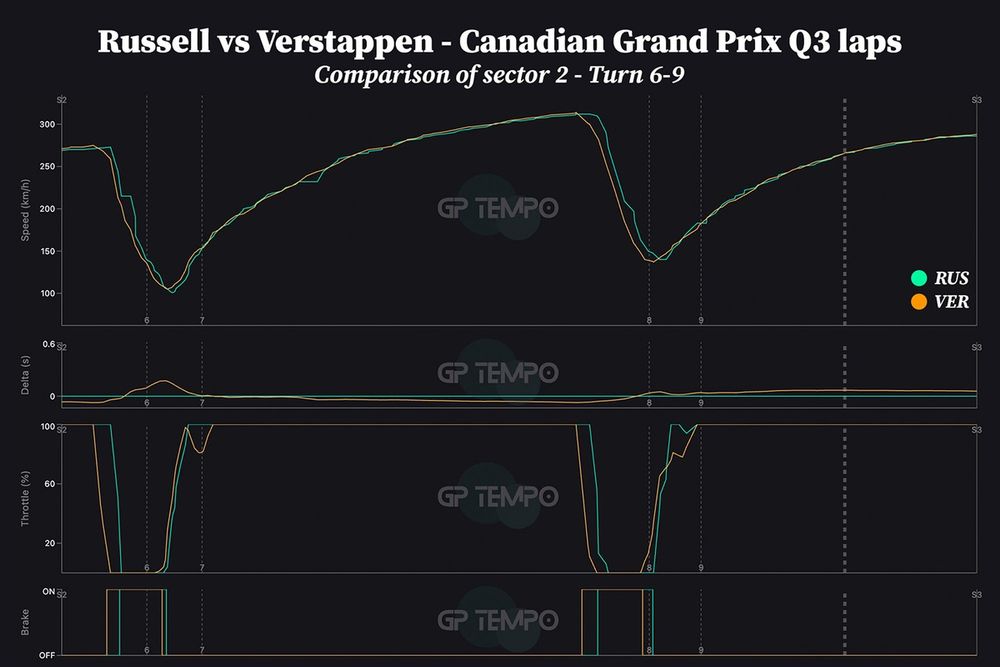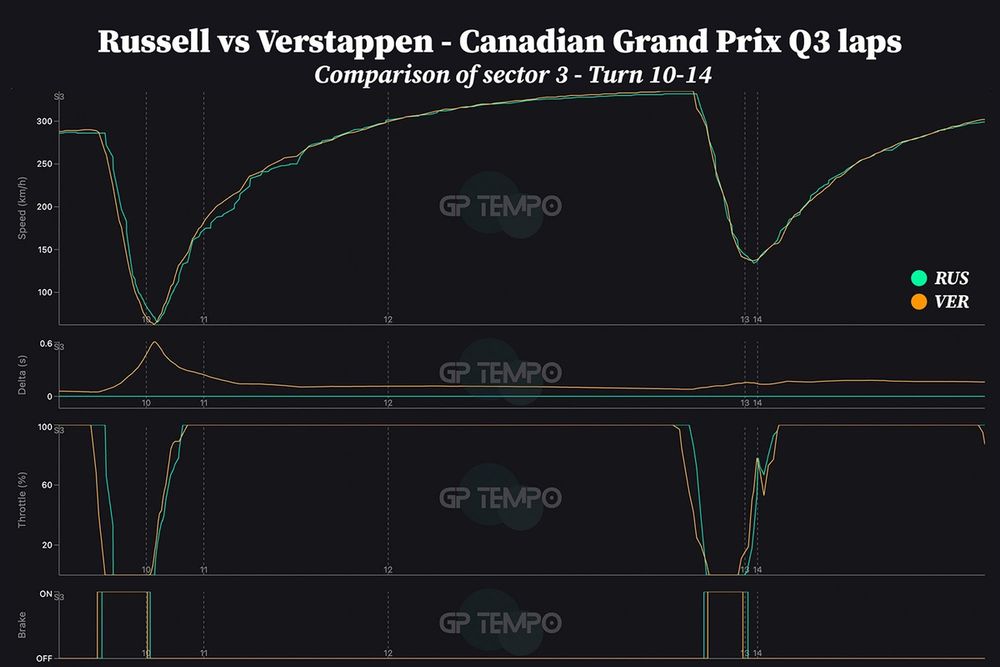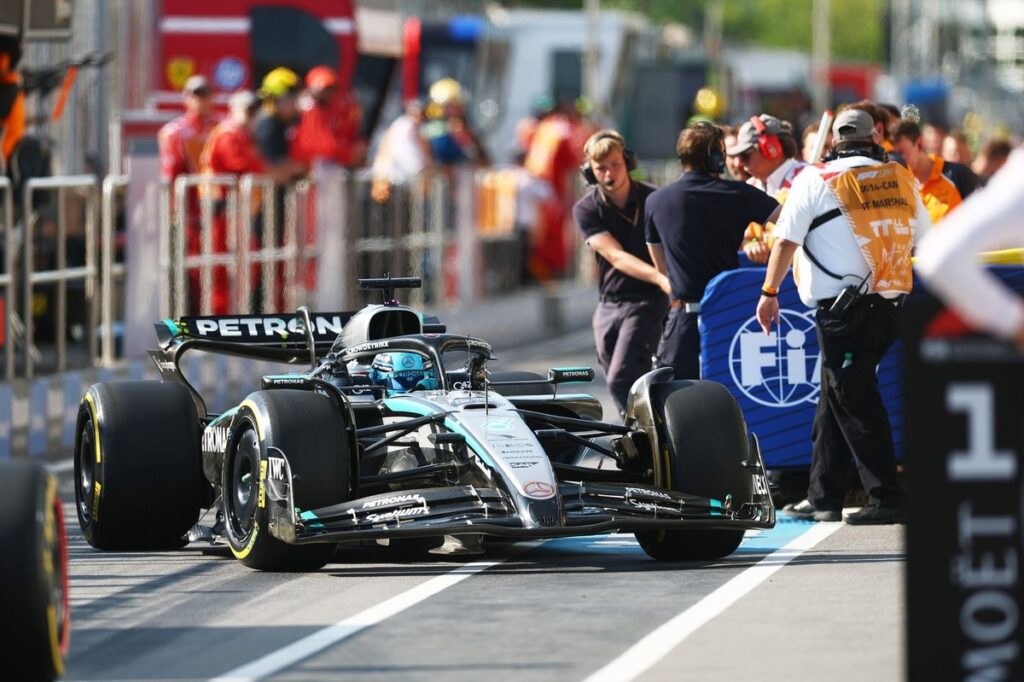The margins in qualifying for the Formula 1 Canadian Grand Prix were impressively small, with a spread of just 0.841 seconds – imagine you’re standing at the finish line, count to one, and the entire field has passed you by.
Although the spread opened up slightly more by the time the top 10 runners had put the finishing touches to their final Q3 laps, the 0.16-second margin that split George Russell and Max Verstappen at the chequered flag denouement was still nip and tuck – albeit positively gargantuan versus their identical times at the front of last year’s grid.
Russell had looked like a pole contender all weekend, as Mercedes seemed to find a strong vein of form on its arrival to Canada. Red Bull and Verstappen, meanwhile, had to build up to it; the world champion complained of heavy steering in FP1 and brake inconsistencies in the subsequent practice sessions, but eventually found ‘the window’ of peak performance.
Both drivers took on the medium tyres for their last hurrah. The appearance of Pirelli’s C6 on the Montreal menu once again opened the internal debate over which tyres would work best in qualifying; although the C6 was apparently worth an extra 0.1-0.15s in hand over a lap, the C5 medium could hold on a little better towards the end of the lap.
Verstappen had set the benchmark in Q3 after overturning Oscar Piastri’s very brief stint at the top of the leaderboards – but Russell soon ended his interregnum with a last-gasp play for pole. Here’s how their laps compared.
First sector: Verstappen finds slender advantage
In the opening split, it was Verstappen who’d actually found time – and by the entry into Turn 6, he was 0.063s up on Russell. The entirety of that came in their divergent approaches to Turn 1 and 2, where Russell came off full throttle sooner and simultaneously got on the brakes quicker. Verstappen took a later approach to the brakes on the entry to Turn 1, and maintained a consistent braking profile.
George Russell, Mercedes vs Max Verstappen, Red Bull Racing
This allowed the Red Bull driver to get onto the power earlier, as Russell took a very different approach; perhaps to settle the car, the Briton came off the brakes on the transition to the Turn 2 hairpin, added a little bit more throttle, but the Riverdance-esque approach to the pedals through the corner ensured that he had to brake once again and thus picked up the power a little bit later. That contributed to a difference of over a tenth between them, although Russell did at least manage to chip away at that with marginally stronger acceleration.
Russell then got off the throttle later into Turn 3 to carry more speed through the right hander, picking it up again a touch later out of Turn 4 to almost half the deficit he’d accrued on the exit of the opening two corners. It helped that he was actually at 100% throttle travel sooner than Verstappen, as the Dutchman had to lift very slightly on the exit just to stabilise the rear.
Second sector: Swing state helps Russell reverse the deficit
Russell’s much later braking for the Turn 6-7 chicane might have been playing with fire a little bit, given the earlier excursions many drivers faced at the left-right prior to the lap’s first DRS zone, but it (for a brief period at least) allowed him to sit on level terms with Verstappen on the exit of the corner.
The Mercedes driver’s initial throttle pick-up was also a touch later once more, but he was able to bring the pedal to the floor with much more confidence; again, Verstappen needed to modulate it on the exit just to dial in some stability into the rear end. But initially, Verstappen reclaimed his delta through his RB21’s greater efficiency in a straight line; he got up to speed more adeptly and managed to collect a 0.072s advantage on the entry to Turn 8.

George Russell, Mercedes vs Max Verstappen, Red Bull Racing
But here’s where the balance of power shifted between the two. Russell, again, braked later into the Turn 8-9 chicane. Russell, again, was marginally later on picking up the throttle – but got up to full acceleration sooner as Verstappen’s confidence lift came sooner in the exit phase.
This bought Russell a tenth-plus-change, producing the key swing in their respective laps. While the Red Bull acceleration was marginally stronger through the straight itself, Russell had been very slightly braver on the brakes and was now tracking ahead of his Barcelona sparring partner.
Third sector: Russell extends his new advantage
There is a prevailing theme of tentativeness in Verstappen’s braking, perhaps not totally confident following the problems he’d faced over the trio of practice sessions earlier in the weekend. That was magnified in their approaches to the Turn 10 hairpin, where Russell carried much more speed into the second-gear corner.
Hence the big peak on the delta trace where Russell is momentarily up by 0.6s out of the corner. When that normalised, as Russell got on the power later and thus was slightly behind under acceleration, he’d still managed to find a net gain of half a tenth over Verstappen on the exit.

George Russell, Mercedes vs Max Verstappen, Red Bull Racing
It started to fall a bit along the back straight, again a case of Red Bull’s straightline speed simply being stronger than the marginally more-draggy Mercedes W16, culminating in a 0.087s difference between the pair (still in Russell’s favour) in shaping up for the hairpin.
Russell again was a bit later in releasing the throttle, but managed to glide the car through the chicane and set himself up for a more stable exit parallel to the ‘Wall of Champions’; sensing he was very marginally out of position, Verstappen needed to lift very slightly more once again before unlocking the full stable of his Honda powertrain’s horses.
As such, Russell found just under a tenth over the four-time champion, settling at the final 0.16s gap at the finish line.
In this article
Jake Boxall-Legge
Formula 1
Max Verstappen
George Russell
Be the first to know and subscribe for real-time news email updates on these topics
Subscribe to news alerts
Read the full article here

